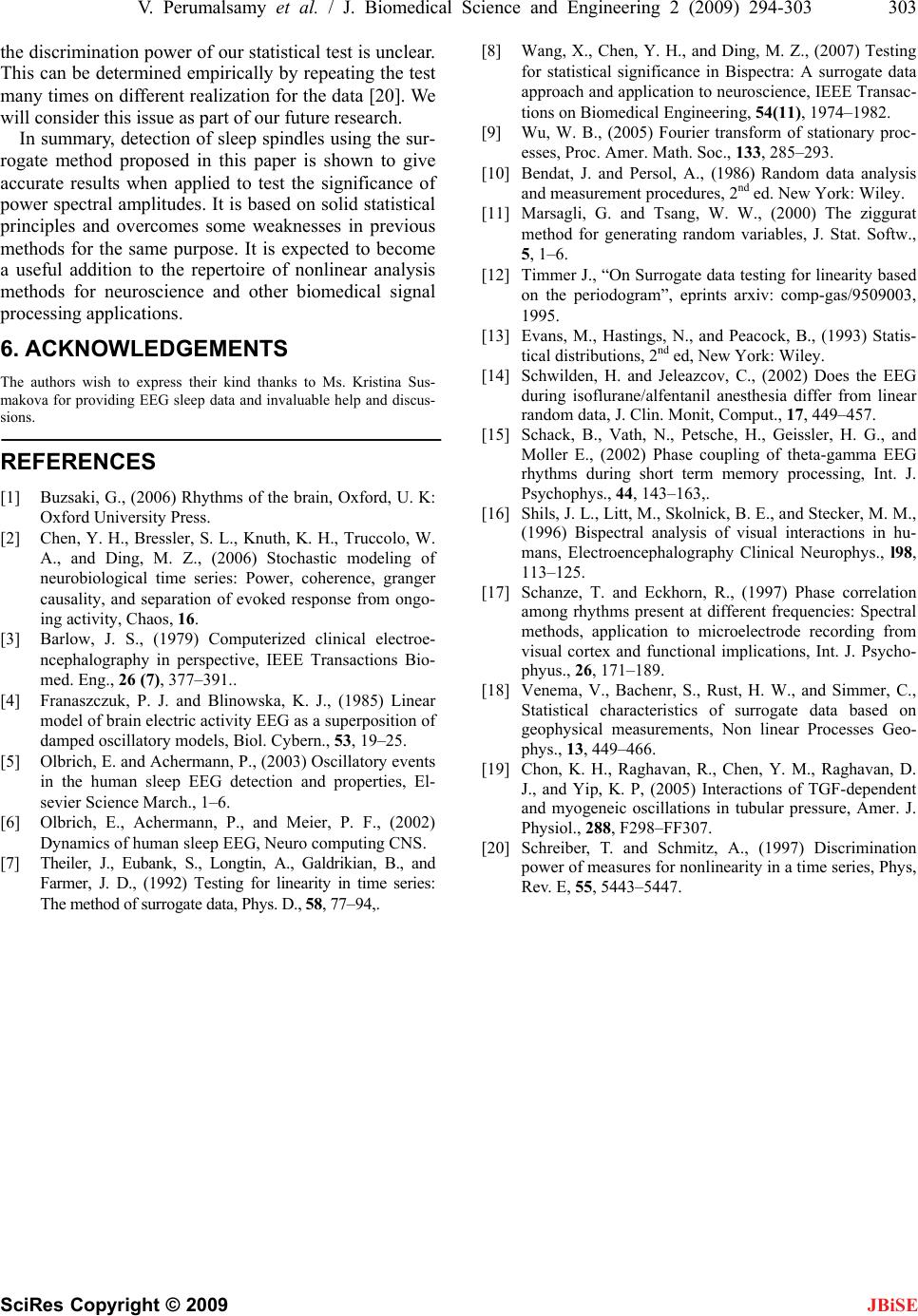
V. Perumalsamy et al. / J. Biomedical Science and Engineering 2 (2009) 294-303 303
SciRes Copyright © 2009 JBiSE
the discrimination power of our statistical test is unclear.
This can be determined empirically by repeating the test
many times on different realization for the data [20]. We
will consider this issue as part of our future research.
In summary, detection of sleep spindles using the sur-
rogate method proposed in this paper is shown to give
accurate results when applied to test the significance of
power spectral amplitudes. It is based on solid statistical
principles and overcomes some weaknesses in previous
methods for the same purpose. It is expected to become
a useful addition to the repertoire of nonlinear analysis
methods for neuroscience and other biomedical signal
processing applications.
6. ACKNOWLEDGEMENTS
The authors wish to express their kind thanks to Ms. Kristina Sus-
makova for providing EEG sleep data and invaluable help and discus-
sions.
REFERENCES
[1] Buzsaki, G., (2006) Rhythms of the brain, Oxford, U. K:
Oxford University Press.
[2] Chen, Y. H., Bressler, S. L., Knuth, K. H., Truccolo, W.
A., and Ding, M. Z., (2006) Stochastic modeling of
neurobiological time series: Power, coherence, granger
causality, and separation of evoked response from ongo-
ing activity, Chaos, 16.
[3] Barlow, J. S., (1979) Computerized clinical electroe-
ncephalography in perspective, IEEE Transactions Bio-
med. Eng., 26 (7), 377–391..
[4] Franaszczuk, P. J. and Blinowska, K. J., (1985) Linear
model of brain electric activity EEG as a superposition of
damped oscillatory models, Biol. Cybern., 53, 19–25.
[5] Olbrich, E. and Achermann, P., (2003) Oscillatory events
in the human sleep EEG detection and properties, El-
sevier Science March., 1–6.
[6] Olbrich, E., Achermann, P., and Meier, P. F., (2002)
Dynamics of human sleep EEG, Neuro computing CNS.
[7] Theiler, J., Eubank, S., Longtin, A., Galdrikian, B., and
Farmer, J. D., (1992) Testing for linearity in time series:
The method of surrogate data, Phys. D., 58, 77–94,.
[8] Wang, X., Chen, Y. H., and Ding, M. Z., (2007) Testing
for statistical significance in Bispectra: A surrogate data
approach and application to neuroscience, IEEE Transac-
tions on Biomedical Engineering, 54(11), 1974–1982.
[9] Wu, W. B., (2005) Fourier transform of stationary proc-
esses, Proc. Amer. Math. Soc., 133, 285–293.
[10] Bendat, J. and Persol, A., (1986) Random data analysis
and measurement procedures, 2nd ed. New York: Wiley.
[11] Marsagli, G. and Tsang, W. W., (2000) The ziggurat
method for generating random variables, J. Stat. Softw.,
5, 1–6.
[12] Timmer J., “On Surrogate data testing for linearity based
on the periodogram”, eprints arxiv: comp-gas/9509003,
1995.
[13] Evans, M., Hastings, N., and Peacock, B., (1993) Statis-
tical distributions, 2nd ed, New York: Wiley.
[14] Schwilden, H. and Jeleazcov, C., (2002) Does the EEG
during isoflurane/alfentanil anesthesia differ from linear
random data, J. Clin. Monit, Comput., 17, 449–457.
[15] Schack, B., Vath, N., Petsche, H., Geissler, H. G., and
Moller E., (2002) Phase coupling of theta-gamma EEG
rhythms during short term memory processing, Int. J.
Psychophys., 44, 143–163,.
[16] Shils, J. L., Litt, M., Skolnick, B. E., and Stecker, M. M.,
(1996) Bispectral analysis of visual interactions in hu-
mans, Electroencephalography Clinical Neurophys., l98,
113–125.
[17] Schanze, T. and Eckhorn, R., (1997) Phase correlation
among rhythms present at different frequencies: Spectral
methods, application to microelectrode recording from
visual cortex and functional implications, Int. J. Psycho-
phyus., 26, 171–189.
[18] Venema, V., Bachenr, S., Rust, H. W., and Simmer, C.,
Statistical characteristics of surrogate data based on
geophysical measurements, Non linear Processes Geo-
phys., 13, 449–466.
[19] Chon, K. H., Raghavan, R., Chen, Y. M., Raghavan, D.
J., and Yip, K. P, (2005) Interactions of TGF-dependent
and myogeneic oscillations in tubular pressure, Amer. J.
Physiol., 288, F298–FF307.
[20] Schreiber, T. and Schmitz, A., (1997) Discrimination
power of measures for nonlinearity in a time series, Phys,
Rev. E, 55, 5443–5447.